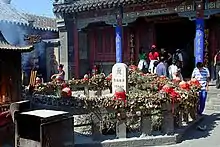Feng Shan
Feng Shan or feng-shan (Chinese: 封禪), also referred to as the Feng and Shan sacrifices, was an official rite offered by the Son of Heaven (kings of Zhou and later emperors of China) to pay homage to heaven and earth. The sacrifices were usually offered at Mount Tai, the highest peak in the area, and nearby Mount Liangfu. The emperor would pay homage to heaven (on the summit) and earth (at the foot of the mountain) in the Feng (Chinese: 封; pinyin: Fēng) and Shan (Chinese: 禪; pinyin: Shàn) sacrifices respectively.[1] Completing Feng Shan allowed the emperor to receive the mandate of heaven. [2] The term feng can roughly be translated to mean "to seal", while the term shang can roughly be translated to mean "to clear away".

According to the Records of the Grand Historian, Feng involved building altars out of soil at the peak of Mt. Tai and proclaiming the merits and legitimacy of the emperor to god of heaven. Shan involved clearing land at the foot of the mountain to show respect for the god of earth.[3][4]
History
Worship at Mount Tai began in prehistoric times and continued through the Zhou dynasty. During the Warring States Period, Mount Tai was located on the border between Qi and Lu, and leaders from both nations would carry out sacrifices at the mountain. In 219 BC, Qin Shihuang carried out what would come to be considered the first Feng and Shan sacrifices in celebration of uniting China. [5] The second emperor to carry out the sacrifices was Emperor Wu of Han. Emperor Gaozong of Tang carried out the Feng and Shan sacrifices more times than any other emperor in Chinese history. Japan, India, the Persian court in exile, Goguryeo, Baekje, Silla, the Turks, Khotan, the Khmer, and the Umayyad Caliphate all had representatives attending the Feng and Shan sacrifices held by Emperor Gaozong of Tang in 666 at Mount Tai.[6] Wu Zetian carried out Feng and Shan sacrifices at Mount Song. The last emperor to carry out Feng and Shan sacrifices was Emperor Zhenzong of the Song dynasty.[7] Later, emperors in the Qing dynasty would perform similar rites at Mount Tai. There are only six verifiable accounts of performances in all of Chinese history.[8]
References
- Lewis, Mark Edward (18 March 1999). Writing and Authority in Early China. ISBN 9780791441145. Retrieved 31 January 2015.
- Jing, Wang (1992). The Story of Stone: Intertextuality, Ancient Chinese Stone Lore, and the Stone Symbolism in Dream of the Red Chamber, Water Margin, and The Journey to the West. Durham, North Carolina: Duke Press. pp. 66–69. ISBN 082231195X.
- "'Fengshan Sacrifices' at Mount Tai[1]- Taian". www.chinadaily.com.cn. Retrieved 2019-02-25.
- Daji, Lü (2014). Marxism and Religion. Religious Studies in Contemporary China Collection. BRILL. ISBN 978-9047428022.
- Centre, UNESCO World Heritage. "Mount Taishan". UNESCO World Heritage Centre. Retrieved 2019-02-25.
- Skaff 2012, pp. 146-7.
- 中国文化科目认证指南. 华语教学出版社. Sinolingua. 2010. p. 63. ISBN 978-7-80200-985-1.
- Record of the Feng and Shan Sacrifices,” in Donald Lopez, ed., Religions of China in Practice (Princeton: Princeton University Press, 1996), 251-60
